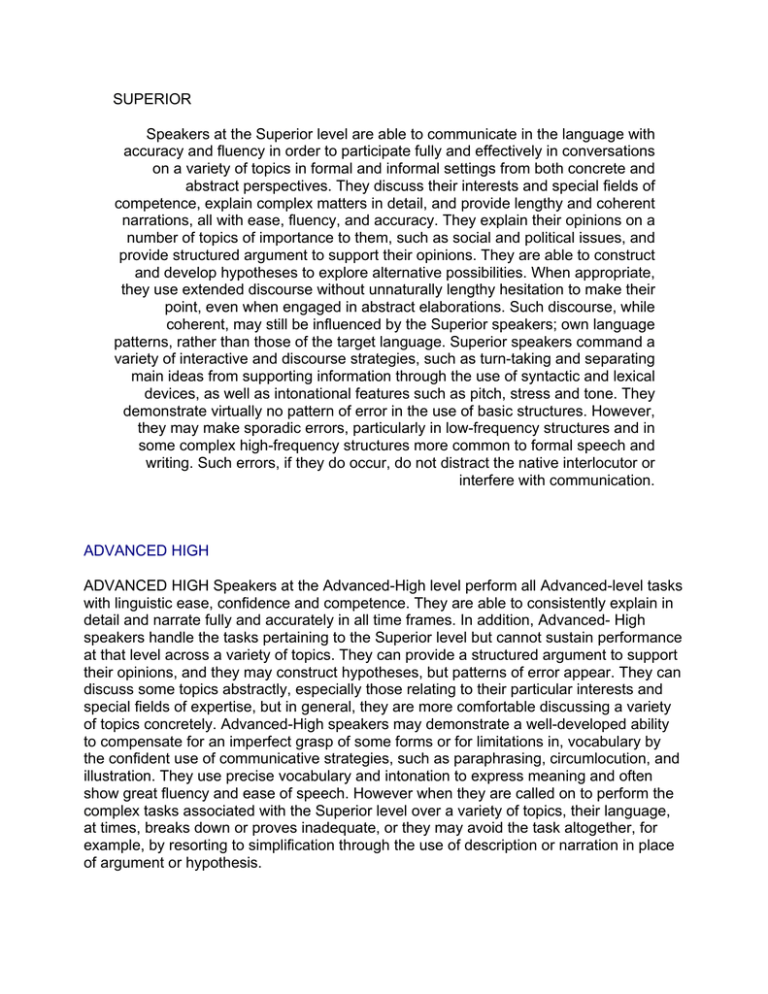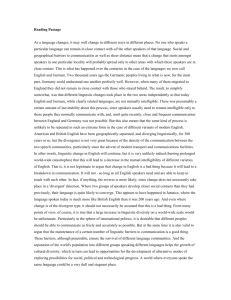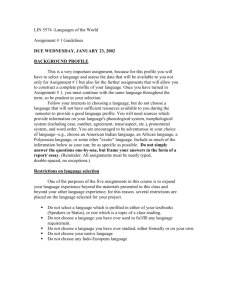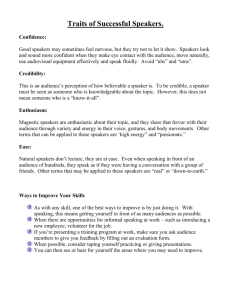SUPERIOR Speakers at the Superior level are able to communicate in... accuracy and fluency in order to participate fully and effectively...
advertisement

SUPERIOR Speakers at the Superior level are able to communicate in the language with accuracy and fluency in order to participate fully and effectively in conversations on a variety of topics in formal and informal settings from both concrete and abstract perspectives. They discuss their interests and special fields of competence, explain complex matters in detail, and provide lengthy and coherent narrations, all with ease, fluency, and accuracy. They explain their opinions on a number of topics of importance to them, such as social and political issues, and provide structured argument to support their opinions. They are able to construct and develop hypotheses to explore alternative possibilities. When appropriate, they use extended discourse without unnaturally lengthy hesitation to make their point, even when engaged in abstract elaborations. Such discourse, while coherent, may still be influenced by the Superior speakers; own language patterns, rather than those of the target language. Superior speakers command a variety of interactive and discourse strategies, such as turn-taking and separating main ideas from supporting information through the use of syntactic and lexical devices, as well as intonational features such as pitch, stress and tone. They demonstrate virtually no pattern of error in the use of basic structures. However, they may make sporadic errors, particularly in low-frequency structures and in some complex high-frequency structures more common to formal speech and writing. Such errors, if they do occur, do not distract the native interlocutor or interfere with communication. ADVANCED HIGH ADVANCED HIGH Speakers at the Advanced-High level perform all Advanced-level tasks with linguistic ease, confidence and competence. They are able to consistently explain in detail and narrate fully and accurately in all time frames. In addition, Advanced- High speakers handle the tasks pertaining to the Superior level but cannot sustain performance at that level across a variety of topics. They can provide a structured argument to support their opinions, and they may construct hypotheses, but patterns of error appear. They can discuss some topics abstractly, especially those relating to their particular interests and special fields of expertise, but in general, they are more comfortable discussing a variety of topics concretely. Advanced-High speakers may demonstrate a well-developed ability to compensate for an imperfect grasp of some forms or for limitations in, vocabulary by the confident use of communicative strategies, such as paraphrasing, circumlocution, and illustration. They use precise vocabulary and intonation to express meaning and often show great fluency and ease of speech. However when they are called on to perform the complex tasks associated with the Superior level over a variety of topics, their language, at times, breaks down or proves inadequate, or they may avoid the task altogether, for example, by resorting to simplification through the use of description or narration in place of argument or hypothesis. ADVANCED MID ADVANCED MID Speakers at the Advanced-Mid level are able to handle with ease and confidence a large number of communicative tasks. They participate actively in most informal and some formal exchanges on a variety of concrete topics relating to work, school, home, and leisure activities, as well as to events of current, public, and personal interest or individual relevance. Advanced-Mid speakers demonstrate the ability to narrate and describe in all major time frames (past, present, and future) by providing a full account, with good control of aspect, as they adapt flexibly to the demands of the conversation. Narration and description tend to be combined and interwoven to relate relevant and supporting facts in connected, paragraph-length discourse. Advanced-Mid speakers can handle successfully and with relative ease the linguistic challenges presented by a complication or unexpected turn of events that occurs within the context of a routine situation or communicative task with which they are otherwise familiar. Communicative strategies such as circumlocution or rephrasing are often employed for this purpose. The speech of Advanced-Mid speakers performing Advanced-level tasks is marked by substantial flow. Their vocabulary is fairly extensive although primarily generic in nature, except in the case of a particular area of specialization or interest. Dominant language discourse structures tend to recede, although discourse may still reflect the oral paragraph structure of their own language rather than that of the target language. Advanced-Mid speakers contribute to conversations on a variety of familiar topics, dealt with concretely, with much accuracy, clarity and precision, and they convey their intended message without misrepresentation or confusion. They are readily understood by native speakers unaccustomed to dealing with non-natives. When called on to perform functions or handle topics associated with the Superior level, the quality and/or quantity of their speech will generally decline. Advanced-Mid speakers are, often able to state an opinion or cite conditions; however, they lack the ability to consistently provide a structured argument in extended discourse. Advanced-Mid speakers may use a number of delaying strategies, resort to narration, description, explanation or anecdote, or simply attempt to avoid id the linguistic demands of Superior- level tasks. ADVANCED LOW Speakers at the Advanced-Low level are able to handle a variety of communicative tasks, although somewhat haltingly at times. They participate actively in most informal and a limited number of formal conversations on activities related to school, home, and leisure activities and, to a lesser degree, those related to events of work, current, public, and personal interest or individual relevance. Advanced-Low speakers demonstrate the ability to narrate and describe in all major time frames (past, present and future) in paragraph length discourse, but control of aspect may be lacking at times. They can handle appropriately the linguistic challenges presented by a complication or unexpected turn of events that occurs within the context of a routine situation or communicative task with which they are otherwise familiar, though at times their discourse may be minimal for the level and strained. Communicative strategies such as rephrasing and circumlocution may be employed in such instances. In their narrations and descriptions, they combine and link sentences into connected discourse of paragraph length. When pressed for a fuller account, they tend to grope and rely on minimal discourse. Their utterances are typically not longer than a single paragraph. Structure of the dominant language is still evident in the use of false cognates, literal translations, or the oral paragraph structure of the speaker's own language rather than that of the target language. While the language of Advanced-Low speakers may be marked by substantial, albeit irregular flow, it is typically somewhat strained and tentative, with noticeable self-correction and a certain grammatical roughness. The vocabulary of Advanced-Low speakers is primarily generic in nature. Advanced-Low speakers contribute to the conversation with sufficient accuracy, clarity, and precision to convey their intended message without misrepresentation or confusion, and it can be understood by native speakers unaccustomed to dealing with non-natives, even though this may be achieved through repetition and restatement. When attempting to perform functions or handle topics associated with the Superior level, the linguistic quality and quantity of their speech will deteriorate significantly.






